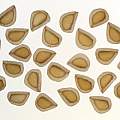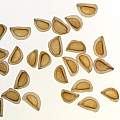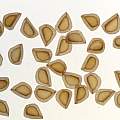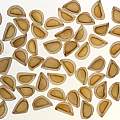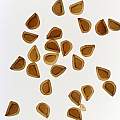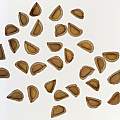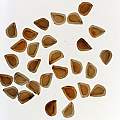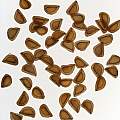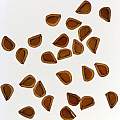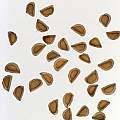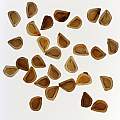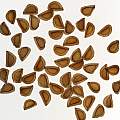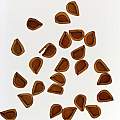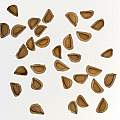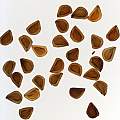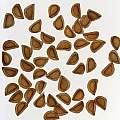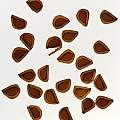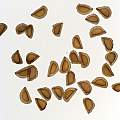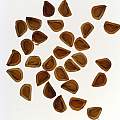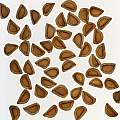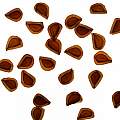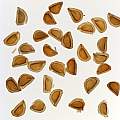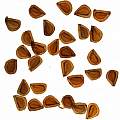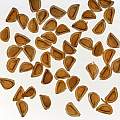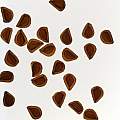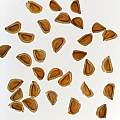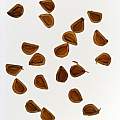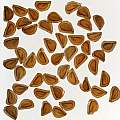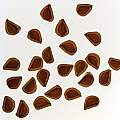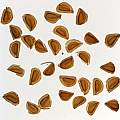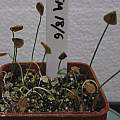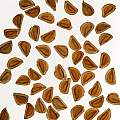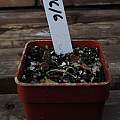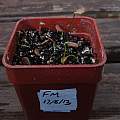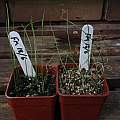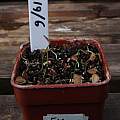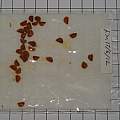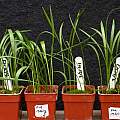This page examines the germination of Fritillaria seed. The theory is that fresh Fritillaria seeds have undeveloped embryos and the embryo only grows when the seed becomes wet and temperatures are low. There is also comment that seed does not remain viable if stored.
To test this, four batches of Fritillaria meleagris seed were made from newly harvested seed in the middle of June 2012. All of them were placed in zip-seal bags; two with moist kitchen towel. Of the four, two were kept at room temperature (70-80 °F) and two at fridge door compartment temperature (measured as 48-50 °F), giving the initial combinations wet+warm, dry+cold, wet+cold and dry+warm. At the start of December all four batches were made wet+cold, simulating the typical storage and sowing of seed obtained through a seed exchange.
Fritillaria seed is semi-transparent, so a transparency scanner can be used to see what is going on inside the seed. It is immediately apparent that the embryos are a lot smaller than found in e.g. Lilium seed. This is an important point for the gardener used to throwing away any lily like seed without a visible embryo.
Other genera with similar seeds which may show similar behaviour and for which there are seed images and discussion on the wiki include Cardiocrinum, Notholirion, Lilium and Tulipa.
Other Fritillaria species on the wiki with seed photos and germination results are Fritillaria acmopetala, Fritillaria affinis, Fritillaria atropurpurea, Fritillaria aurea, Fritillaria camschatcensis, Fritillaria conica, Fritillaria crassifolia, Fritillaria eduardii, Fritillaria graeca, Fritillaria michailovskyi, Fritillaria pyrenaica, Frtillaria stenanthera, Fritillaria uva-vulpis and Fritillaria verticillata. All the results follow the same pattern as Fritillaria meleagris except for Fritillaria camschatcensis.
Note that it has been reported that a period of "warm stratification" is needed for some species of Fritillaria (e.g. Fritillaria camschatcensis), that is, a period of warm and moist conditions before the low temperatures looked at here.
In the images below by David Pilling the four batches are displayed in the same order left to right at various dates. To view the progress of a particular batch follow the relevant column down the page.
Start 16th June 2012
| #1 wet+warm | #2 dry+cold | #3 wet+cold | #4 dry+warm |
Six weeks (44 days), 30th July 2012
| #1 wet+warm | #2 dry+cold | #3 wet+cold | #4 dry+warm |
Eleven weeks (80 days), 4th September 2012
By this point it can be seen that the seeds in #3 have developed embryos, whilst the other batches are unchanged.
| #1 wet+warm | #2 dry+cold | #3 wet+cold | #4 dry+warm |
Eighteen weeks (127 days), 21st October 2012
| #1 wet+warm | #2 dry+cold | #3 wet+cold | #4 dry+warm |
Twenty four weeks (170 days), 3rd December 2012
After these scans the dry seeds had moist kitchen towel added and all the seeds were moved outside. It can be seen that with the lower room temperatures in Autumn there has been a little development in the wet+warm batch.
| #1 wet+warm | #2 dry+cold | #3 wet+cold | #4 dry+warm |
Twenty eight weeks (201 days), 3rd January 2013
Two of the seeds in batch #3, the one longest exposed to cold and wet, are starting to germinate. The outside temperature in this period has been in the range 40-50 °F. There are well developed embryos in batch #1, and signs of growth in #2 and #4. This is already evidence that drying the seeds enough to stop embryo development did not kill them.
| #1 | #2 | #3 | #4 |
Thirty two weeks (227 days), 29th January 2013
By now nine of the seeds in batch #3, the one longest exposed to cold and wet, have germinated and been planted; it can be seen from the scan that a number of others in this batch are germinating. The outside temperature in this period has been in the range 32-40 °F.
| #1 | #2 | #3 | #4 |
Thirty five weeks (246 days), 17th February 2013
All 29 of the seeds in batch #3 have germinated; the last 45 days after the first.
Thirty six weeks (258 days), 1st March 2013
The outside temperature in this period has been in the range 32-40 °F. Seeds in batches #2 and #4, surprisingly the ones initially dry are starting to germinate, and it appears those in batch #1 are not far behind. It is 88 days since batches #2 and #4 had water added, at that time batch #4 (warm+dry) looked hopelessly desiccated. For batch #3 there is a photo of the second of two 2" square pots of seedlings.
| #1 | #2 | #3 | #4 |
Forty weeks (288 days), 31st March 2013
The outside temperature in this period has been in the range 32-40 °F (March was unusually cold in 2013). Photos of the seedlings are shown; after these were taken, the number of seeds that had germinated in each batch was #1 - 15/25, #2 - 17/31, #4 - 33/48.
| #1 | #2 | #3 | #4 |
Forty one weeks (296 days), 8th April 2013
All 25 seeds in batch #1 have germinated; the last 26 days after the first. The number of seeds that have germinated in the other batches are #2 - 24/31, #4 - 38/48.
Forty two weeks (302 days), 14th April 2013
All seeds in batch #4 have germinated leaving one (now) obvious piece of chaff, and in batch #2 all seeds but one with a non-developed embryo have germinated; both of these are visible on the 1st March photos.
Conclusions
The results above back up the idea that the embryos in Fritillaria meleagris seed only develop when the seed is moist and kept at low temperatures. They do not explicitly show how the rate of embryo development varies with temperature, but they hint that it is faster at lower temperatures.
Practically seed without visible embryos should not be thrown away. But there is no point expecting seed without visible embryos to germinate soon, or to germinate at high temperatures (>60°F). No large embryo, no germination and no large embryo until the seed has been exposed to low temperatures (<40°F).
Roughly the embryo grows from one end of the seed to the other and the seed then germinates. One can imagine the embryo as a bar gauge or progress bar, hold the seed up to the light and you can see how close to germinating it is.
The results also demonstrate that the seed will germinate at low temperatures (<40°F), it does not wait for spring. That may be a problem if seedlings are not being kept in frost free conditions.
Half the seeds survived nearly six months of dry storage which makes getting them from a seed exchange sensible. Dryness is relative, with 70% humidity indoors in England nothing is really dry. Weighing the seeds could have provided a measure of how dry they were; Kew SID gives the weight of a seed as 0.0019 g which gives an idea of the precision needed (see weighing seed).
All the seeds in batch #1 came from one seed pod, and all those in batch #2 came from another seed pod, and so on; it would have been better to randomly select the same number of seeds for each batch from a collection of seeds from many seed pods. It was unfortunate the fridge temperature was somewhat high, this probably slowed the progress of the wet+cold batch.
If reading this far has been tedious, consider that it will be another three years before these seeds flower and five years before they flower well.
Background photos, the first is of batch #2 on the 1st of March 2013 (10 mm grid).
Postscript 2014
The photograph shows seedlings from seed batches 1 to 4 (left to right) a year later (13th April 2014). Some of the seed from 2012 was kept dry in the fridge, and sown in 2013, of which only about half germinated.
Asian fritillaria A-C - Asian fritillaria D-K - Asian fritillaria L-R - Asian fritillaria S-Z - European fritillaria A-O - European fritillaria P-Z - Fritillaria index - Miscellaneous fritillaria - North American fritillaria A-L - North American fritillaria M-Z
